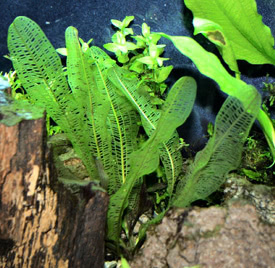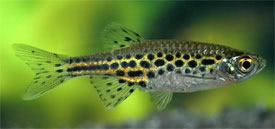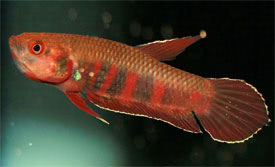
 Magyarul / Hungarian
Magyarul / Hungarian


- Scientific name: Aponogeton madagascariensis
- Synonym: Aponogeton fenestralis; A. henkelianus; A. guillotii
- Common name: Madagascar lace plant, Laceleaf
- Family: Aponogetonaceae
- Group: Aquarium plants
- Max height: 50 cm
- Distribution: Africa; Madagascar, presumably Grande Comore as well as Mauritius
- Habitat: The plants grow in both small forest streams and fast-flowing rivers, and, in exceptional cases, in stagnant water.
- Substrate: Rich with nutrients
- Placement in aquarium: Middleground, Background
- Planting density: 1 plant for 20 cm2
- Lighting needs: Will do well in most conditions, but should be shaded in well-lit aquariums.
- Temperature: 20-26°C
- pH: 5,5-7
- Hardness: 2-6 NK°
Description: The laceleaf has become a popular aquarium plant, mainly due to its novel "skeletonlike" appearance. This is due to a lack of leaf tissue; only the interconnecting veins are visible. It is not an easy plant to care for and requires clean and clear water conditions. Any algae or debris will clog the leaves and undermine the health of the plant. Be sure to keep it in soft water with a pH of 7 or lower. Narrow and wider leaf varieties also available.
Due to its unusual fenestrated leaf structure, A. madagascariensis has undisputedly been one of the most popular aquarium plants for many years, even though a
prolonged and satisfactory culture in the aquarium has rarely been achieved. It is therefore generally not recommended to the "average aquarist," but should only be kept by specialists who can consistently meet the high requirements of this species in the long term: a low temperature level, strong water movement, soft, acid water, nutrient-rich substrate, medium light intensity and regular rest phases (no dry period!). Since A. madagascariensis has recently become commercially available from tissue cultivation, previously held reservations against the purchase of the plants have been largely invalidated because the natural populations are thus no longer decimated.















